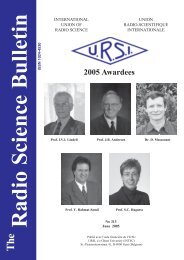Radio Science Bulletin 325 - June 2008 - URSI
Radio Science Bulletin 325 - June 2008 - URSI
Radio Science Bulletin 325 - June 2008 - URSI
- No tags were found...
Create successful ePaper yourself
Turn your PDF publications into a flip-book with our unique Google optimized e-Paper software.
**.modeled TID ionospheres using Haselgrove’s Equations.This approach is reviewed in Section 6.Summary remarks are given in Section 7.2. Ray Focusing and HomingHaselgrove’s Equations are an implementation ofHamilton’s equations suitable for numerical integration ona computer. Haselgrove had in mind the determination ofthe paths of dominant energy flow of radiowaves inanisotropic media, specifically the ionosphere. In the Jones-Stephenson “Raytrace” code [5], these equations are writtenin Earth-centered spherical polar coordinates as∂HrÆ = , (1)∂ krwhere µ is the ionospheric index of refraction, here takento be real (i.e., neglecting absorption). The index of refractioncan be spatially varying and generally anisotropic, like theµ = µ r, θ, φ, k , k , k .ionosphere. That is, in general ( r θ φ)Haselgrove’s Equations trace the paths of dominantenergy flow. This can be understood in the following way.Consider all possible paths connecting two points. Thosepaths about which small spatial path deviations causesignificant phase changes cannot efficiently propagateenergy: significant phase changes result in destructiveinterference and do not allow energy transport. Only thosepaths with stationary phase for which small spatial deviationsresult in little or no phase change will have nearby “microrays”arriving in phase, interfering constructively andallowing significant levels of energy transport. Hamilton’sequations are an expression of the principle of stationaryphase, being derived by the calculus of variations fromFermat’s principle of stationary phase,Here, ( , , )1 ∂HÆθ = , (2)r ∂ k θ1 ∂Hϕ = , (3)Æ rsinθ∂k ϕ∂Hk Æ r =− + kθθÆ + kϕsinθϕ, (4)∂rÆ1 ∂H1Æk θ =− − k r k cosr θ rθ Æ +∂ϕ θϕ Æ , (5)1 ∂H1 cosθ Æk ϕ =− − k r krsinrϕ Æ ϕ θÆ− . (6)θ ∂ϕ sinθr θφ are the usual spherical polar coordinates,and ( kr, kθ,kφ ) are the wave vector components in the( ˆr , ˆ2 2 2 2θ , ˆϕ ) directions, with k = kr+ kθ+ kϕ. Additionaltime-frequency equations can be included for timedependentionospheres. The dot refers to differentiationwith respect to any parameter that varies monotonicallyalong the ray path. The Hamiltonian can be taken as any ofa number of possible expressions of the dispersion relation[1], for example,21 ⎡c2 2⎤H = ⎢ k −µ2 2⎥ , (7)⎢⎣ω⎥⎦b0 = δ k•ds(8)∫aHere, δ represents any spatial variation of a path betweenpoints a and b, with the endpoints remaining fixed, and theintegral is over the path. Any equations derived fromEquation (8) using the variational calculus, as areEquations (1)-(6), will embody phase stationarity. Hence,Haselgrove’s Equations describe the paths of dominantenergy flow in an ionosphere with spatially varying andgenerally anisotropic index of refraction. These stationaryphase paths are referred to as “rays,” and the numericalsolution of the Haselgrove Equations is referred to as “raytracing.”The equations for an infinitesimal flux tube about agiven ray can be derived using secondary variations ofHaselgrove’s Equations. I did this for the isotropicionosphere in [11]. Bennett [12] cited other independentdiscoveries of similar methods. The generalization toanisotropic ionospheres was developed by Västberg andLundborg [13]. Using the example of the spherical polarcoordinate expression of Haselgrove’s Equations inEquations (1)-(6), the idea is simply to vary these equationswith respect to the independent variables ( r, θφ , ) and( kr, kθ,kφ ) by differentiation to develop equations forδrÆ Æ, δθ, δϕÆÆ Æ Æ, δkr, δkθ,δkϕin terms of infinitesimaldeviations δr, δθ, δϕ, δkr, δkθ,δ kϕ. I will not repeat theequations here, as the expressions are fairly long, but referthe reader to [11]. These equations, like Haselgrove’sEquations, are suitable for numerical integration on acomputer. The integration can be initiated with deviationscorresponding to infinitesimal elevation and azimuth offsetsfrom a primary ray direction, with the integrated resultgiving the infinitesimally separated positions and directionsof the offset rays from the primary ray at the end of the raypath. Key to the success of this formulation is that whenpower density is calculated (power per unit area), the size of38The<strong>Radio</strong> <strong>Science</strong> <strong>Bulletin</strong> No <strong>325</strong> (<strong>June</strong> <strong>2008</strong>)
















